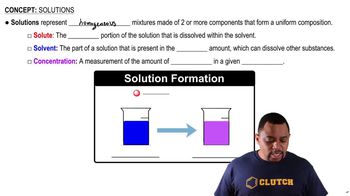Here are the essential concepts you must grasp in order to answer the question correctly.
Molarity
Molarity (M) is a measure of concentration defined as the number of moles of solute per liter of solution. To prepare a specific molarity, one must calculate the required amount of solute based on the desired volume and concentration. In this case, a 0.100 M solution means that for every liter of solution, there are 0.100 moles of fluoride ions.
Recommended video:
Stoichiometry of Calcium Fluoride
Calcium fluoride (CaF2) dissociates in water to produce calcium ions (Ca²⁺) and fluoride ions (F⁻). Each mole of CaF2 yields two moles of fluoride ions. Therefore, to prepare a solution with a specific concentration of fluoride ions, one must account for this stoichiometric relationship when calculating the mass of CaF2 needed.
Recommended video:
Glassware for Solution Preparation
The appropriate glassware for preparing a solution includes a volumetric flask and a balance. A volumetric flask allows for precise measurement of the desired volume (250 mL in this case), while a balance is used to accurately weigh the solid CaF2. Proper use of these tools ensures the solution's concentration is accurate and reproducible.
Recommended video:
 Verified step by step guidance
Verified step by step guidance


